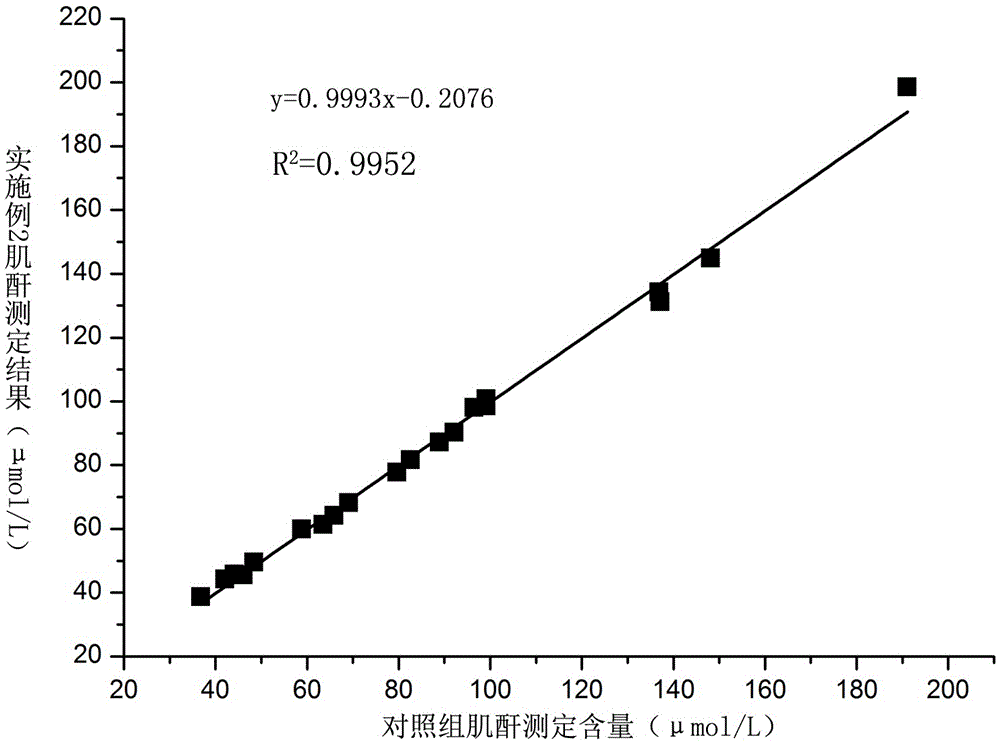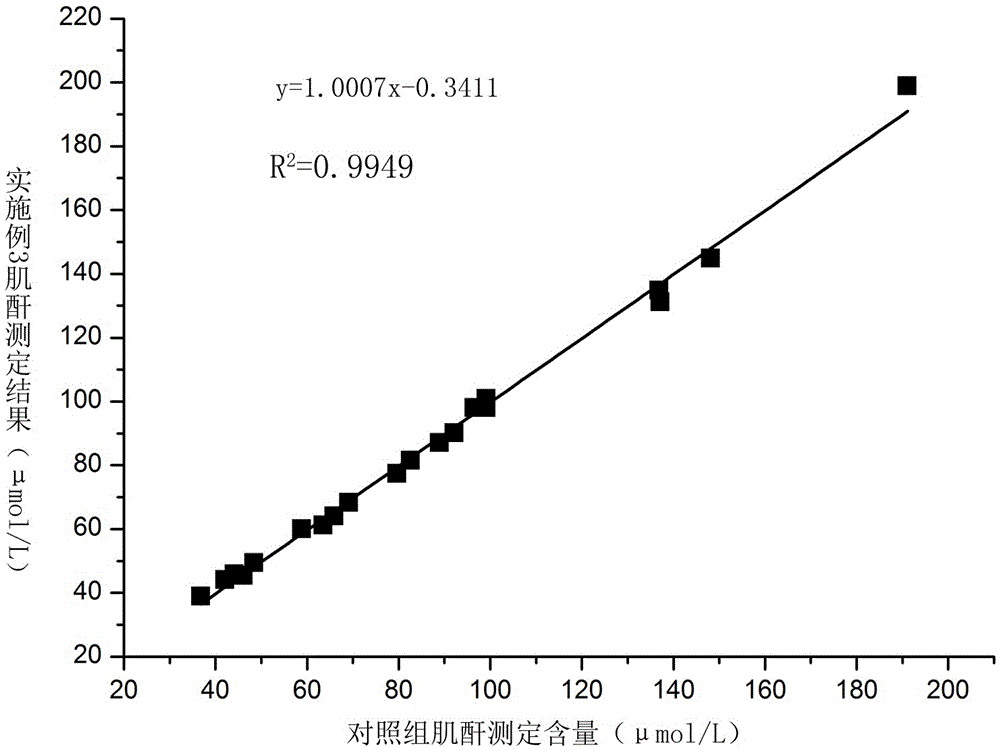A serum creatinine detection reagent
A technology for detecting reagents and serum creatinine, which is applied in biological tests, measuring devices, material inspection products, etc., can solve the problems of unsatisfactory detection effect, weak anti-interference ability, low precision and accuracy, etc. Strong anti-interference ability and sensitivity, the effect of high analytical sensitivity
- Summary
- Abstract
- Description
- Claims
- Application Information
AI Technical Summary
Problems solved by technology
Method used
Image
Examples
Embodiment 1
[0072] A serum creatinine detection reagent comprises reagent R1 and reagent R2, and adopts liquid double reagent colorimetric method to test the content of creatinine in serum, and the main components of the reagent are as follows:
[0073] Reagent R1 consists of:
[0074] Tris buffer (pH7.8) 10mmol / L
[0075] Creatinase 2KU / L
[0076] Sarcosine oxidase 6KU / L
[0077] Ascorbate oxidase 1KU / L
[0078] Lipase 1KU / L
[0079] Lipoprotein lipase 1KU / L
[0080] Bilirubin oxidase 1KU / L
[0081] γ-Fe 2 o 3 Nanoparticles 10mmol / L
[0082] TOOS0.1mmol / L
[0083] 4-aminoantipyrine 0.1mmol / L
[0084]Potassium ferrocyanide 10μmol / L
[0085] BSA0.1g / L
[0086] Sucrose 5g / L
[0087] Peroxidase 1.5KU / L
[0088] Tween-200.8g / L
[0090] Reagent R2 consists of:
[0091] Tris buffer (pH7.8) 10mmol / L
[0092] Creatinase 55KU / L
[0093] BSA0.5g / L
[0094] Sucrose 5g / L
[0095] Tween-200.8g / L
[0097] γ-Fe in the above r...
Embodiment 2
[0099] A serum creatinine detection reagent comprises reagent R1 and reagent R2, the main components of which are as follows:
[0100] Reagent R1 consists of:
[0101] Tris buffer (pH7.8) 45mmol / L
[0102] Creatinase 18KU / L
[0103] Sarcosine oxidase 15KU / L
[0104] Ascorbate oxidase 15KU / L
[0105] Lipase 10KU / L
[0106] Lipoprotein lipase 10KU / L
[0107] Bilirubin oxidase 10KU / L
[0108] Nanoparticles 50mmol / L
[0109] TOOS0.6mmol / L
[0110] 4-Aminoantipyrine 0.4mmol / L
[0111] Potassium ferrocyanide 20μmol / L
[0112] BSA3g / L
[0113] Sucrose 20g / L
[0114] Peroxidase 3KU / L
[0115] Tween-201.5g / L
[0117] Reagent R2 consists of:
[0118] Tris buffer (pH7.8) 45mmol / L
[0119] Creatinase 80KU / L
[0120] BSA3g / L
[0121] Sucrose 20g / L
[0122] Tween-201.5g / L
[0123] Sodium azide 3g / L.
[0124] γ-Fe in the above reagent R1 2 o 3 The particle size of nanoparticles is 20-50nm.
Embodiment 3
[0126] A serum creatinine detection reagent comprises reagent R1 and reagent R2, the main components of which are as follows:
[0127] Reagent R1 consists of:
[0128] Tris buffer (pH7.8) 40mmol / L
[0129] Creatinase 16KU / L
[0130] Sarcosine oxidase 8KU / L
[0131] Ascorbate oxidase 5KU / L
[0132] Lipase 4KU / L
[0133] Lipoprotein lipase 5KU / L
[0134] Bilirubin oxidase 3KU / L
[0135] Nanoparticles 40mmol / L
[0136] TOOS0.4mmol / L
[0137] 4-aminoantipyrine 0.13mmol / L
[0138] Potassium ferrocyanide 20μmol / L
[0139] BSA1g / L
[0140] Sucrose 10g / L
[0141] Peroxidase 2KU / L
[0142] Tween-201g / L
[0143] Sodium azide 1.5g / L;
[0144] Reagent R2 consists of:
[0145] Tris buffer (pH7.8) 40mmol / L
[0146] Creatinase 60KU / L
[0147] BSA1g / L
[0148] Sucrose 10g / L
[0149] Tween-201g / L
[0150] Sodium azide 1.5g / L.
[0151] γ-Fe in the above reagent R1 2 o 3 The particle size of nanoparticles is 20-30nm.
PUM
| Property | Measurement | Unit |
|---|---|---|
| particle diameter | aaaaa | aaaaa |
| particle diameter | aaaaa | aaaaa |
| particle diameter | aaaaa | aaaaa |
Abstract
Description
Claims
Application Information
 Login to View More
Login to View More - R&D
- Intellectual Property
- Life Sciences
- Materials
- Tech Scout
- Unparalleled Data Quality
- Higher Quality Content
- 60% Fewer Hallucinations
Browse by: Latest US Patents, China's latest patents, Technical Efficacy Thesaurus, Application Domain, Technology Topic, Popular Technical Reports.
© 2025 PatSnap. All rights reserved.Legal|Privacy policy|Modern Slavery Act Transparency Statement|Sitemap|About US| Contact US: help@patsnap.com



